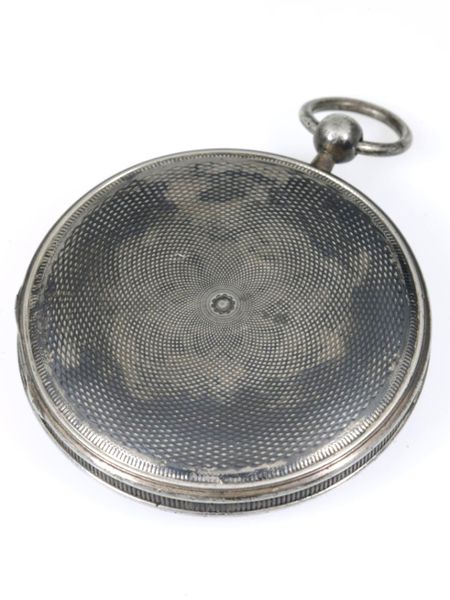Datei:Jacques-Frédéric Houriet au Locle, circa 1810 (2).jpg

Originaldatei (639 × 852 Pixel, Dateigröße: 127 KB, MIME-Typ: image/jpeg)
Jacques-Frédéric Houriet au Locle, 63 mm, 89 g, circa 1810

|
Alle Bildrechte liegen bei dem Auktionshaus Auktionen Dr. H. Crott. Diese Abbildung ist urheberrechtlich geschützt und steht nicht unter einer freien Lizenz. Für anderweitige Nutzungen außerhalb von Watch-Wiki ist die schriftliche Zustimmung des Urheberrechtsinhabers nötig. |
Seltenes Taschenthermometer mit Uhrenständer in Form einer Bronzeskulptur des griechischen Gottes Chronos als geflügelter, bärtiger Greis mit Sichel auf grünem Marmorsockel, Höhe 320 mm
Geh.: Silber, guillochiert, rändiertes Mittelteil. Ziffbl.: Email, Skaleneinteilung außen in Fahrenheit und innen in Reaumur und Einteilung
"Degrés du froid - Glace - Degrés du chaud". Werk: Vollplatinenwerk, große U-förmige Bimetallfeder, Messingrechen.
Ein ähnliches Taschenthermometer ist abgebildet und beschrieben in Jean-Claude Sabrier "Jacques-Frédéric Houriet 1743-1830", Cernier 2006, Seite 114, sowie in John M.R. Knudsen "Urban Jürgensen & Sönner", Kopenhagen 2003, Seite 97.
A rare pocket thermometer with a watch stand in the form of a bronze figure on a green marble base of the Greek god Chronos, shown as a winged and bearded old man with a sickle, Height 320 mm Case: silver, engine-turned, reeded band. Dial: enamel, outer divisions in Fahrenheit, inner divisions in Reaumur and graduations "Degrés du froid - Glace - Degrés du chaud". Movm.: full plate movement, large u-shaped bimetallic spring, brass rack.
A similar piece is illustrated and described in: "Jacques-Frédéric Houriet 1743-1830" by Jean-Claude Sabrier, Cernier 2006, p. 114 and in: "Urban Jürgensen & Sönner" by John M.R. Knudsen, Copenhagen 2003, p. 97.
Jacques-Frédéric Houriet was born on February 25th, 1748 in La Chaux dAbel, which is located near La Ferriere. From 1759 to 1768 he apprenticed and worked in Paris for Julien le Roy, Pierre le Roy and Ferdinand Berthoud. While working for Berthoud he collaborated with Ferdinands nephew, (Pierre) Louis Berthoud. During his time in Paris he formed friendships with Abraham Louis Breguet, Jean Romilly, Antide Janvier and Louis Recordon. After his years of study in the capital of France he returned to Switzerland to establish himself in Le Locle. At first he worked together with his brother and his two sisters. A short while after he became business partners with David Courvoisier, who at the time was the head of the firm Courvoisier & Films. In 1797 Urban Jürgensen became his employee. A few years later Jürgensen married Houriets daughter, Sophie-Henriette. In 1818, at the age of 75, Houriet decided to continue working alone. He only manufactured pocket chronometers and custom-made items. Despite his old age he carried on with research and experiments on the foundation of isochronism, temperature compensation and the effects of magnetism of chronometers. This is how golden, or more specifically spheric hair springs emerge, which appear in the form of an orb or a spheroid. Jacques- Houriet is considered the founder of Swiss chronometry. He was a member of the Paris Academy of Sciences and honorary member of the Genevan Society of Arts. Jacques-Frédéric Houriet died on January 12th, 1830. Source: www.watch-wiki.org/index.php?title=Houriet,_Jacques-Fr%C3%A9d%C3%A9ric, as of 09/29/2013.
Dateiversionen
Klicke auf einen Zeitpunkt, um diese Version zu laden.
| Version vom | Vorschaubild | Maße | Benutzer | Kommentar | |
|---|---|---|---|---|---|
| aktuell | 15:09, 26. Apr. 2018 |  | 639 × 852 (127 KB) | Andriessen (Diskussion | Beiträge) | Jacques-Frédéric Houriet au Locle, 63 mm, 89 g, circa 1810 {{Bildrechte U|dem Auktionshaus Auktionen Dr. H. Crott}} {{Category Picture gallery watch models Houriet, Jacques-Frédéric}} Seltenes Taschenthermometer mit Uhrenständer in Form ein… |
Du kannst diese Datei nicht überschreiben.
Dateiverwendung
Keine Seiten verwenden diese Datei.
- Bildgalerie Uhrenmodelle Houriet, Jacques-Frédéric
- Picture gallery watch models Houriet, Jacques-Frédéric
- Galería de imagenes de modelos de relojes Houriet, Jacques-Frédéric
- Afbeeldingen galerij uurwerkmodellen Houriet, Jacques-Frédéric
- Фотогалерея Модели часов Houriet, Jacques-Frédéric
- Galleria fotografica di modelli orologi Houriet, Jacques-Frédéric